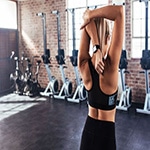Coaches Corner: Negative reps are great for people who can’t do a single pull-up. They can also help you bust through a plateau because eccentric strength is greater than concentric strength. To clarify my point, there will come a time when you can’t bench press the weight off your chest and you’ll need a spotter to help the bar up. At the top position, you can lower the bar slowly because your stores of negative strength aren’t terribly affected by the exercise. Hitting different fast-twitch muscle fibers with negatives is a vital resource to tap. The best negative pull-ups, in my opinion, are those where you grab hold of a pull-up bar and assist yourself up to the top position. Jump up or use a box to bring your chin over the bar, avoid a freefall, attempt to maintain good form, and control your descent as much as possible. Strength WOD Three sets of: Pull-Ups x 3-5 reps @ 51A1 (These are controlled negatives. Use some kind of assist to begin the movement with your chin over the bar, hold for one second, then lower yourself to full lockout over the span of 5 seconds. Shake out in between reps as needed, and load these with as much weight at possible while maintaining a 5 second descent.) Rest 10 seconds Russian Step-Ups w/ Hip Heist x 8 reps each leg Rest 10 seconds Jump Rope Technique Practice x 45-60 seconds Rest 10 seconds 
 WOD (workout of the day) 12-9-6 Front Rev Rack Lunges (95/65) Strict Pull ups rest 2 minutes x 3 rounds
WOD (workout of the day) 12-9-6 Front Rev Rack Lunges (95/65) Strict Pull ups rest 2 minutes x 3 rounds 

 It is correct to avoid excessive forward movement of the knee during squatting and lunging movements. It is a myth, however, that you should “never let your knees go past your toes while doing a squat or lunge.” This belief originated from a study that is more than 30 years old (1978 Duke University study that found maintaining a vertical lower leg as much as possible reduced shearing forces on the knee during a squat). The truth is that leaning forward too much is more likely what is truly causing the problem or injury. In 2003, University of Memphis research confirmed that knee stress increased by 28% when the knees were allowed to move past the toes while performing a squat. However, hip stress increased nearly 1,000% when forward movement of the knee was restricted. In addition, in group exercise, the cue “don’t let your knees go over your toes” has long been an effective general rule when trying to teach an exercise to a room full of people with different skill levels, abilities and goals. When a class has a large number of participants it is difficult to help each individual participant with their specific range-of-motion so providing a general “don’t let your knees go past your toes” cue is an effective way of erring on the side of caution for the exercise instructor. The general pointer while performing a lunge is to try to keep your knees aligned over your second toe so that the knee is moving in the same direction as the ankle joint. However, in reality we often find the knee translating (moving) forward to the toes or beyond in a squat or lunge movement, so there are other things that must be considered. The reason for this can be attributed to the length of limbs (shinbones or tibia/fibula and the thigh bone or femur).]]>
It is correct to avoid excessive forward movement of the knee during squatting and lunging movements. It is a myth, however, that you should “never let your knees go past your toes while doing a squat or lunge.” This belief originated from a study that is more than 30 years old (1978 Duke University study that found maintaining a vertical lower leg as much as possible reduced shearing forces on the knee during a squat). The truth is that leaning forward too much is more likely what is truly causing the problem or injury. In 2003, University of Memphis research confirmed that knee stress increased by 28% when the knees were allowed to move past the toes while performing a squat. However, hip stress increased nearly 1,000% when forward movement of the knee was restricted. In addition, in group exercise, the cue “don’t let your knees go over your toes” has long been an effective general rule when trying to teach an exercise to a room full of people with different skill levels, abilities and goals. When a class has a large number of participants it is difficult to help each individual participant with their specific range-of-motion so providing a general “don’t let your knees go past your toes” cue is an effective way of erring on the side of caution for the exercise instructor. The general pointer while performing a lunge is to try to keep your knees aligned over your second toe so that the knee is moving in the same direction as the ankle joint. However, in reality we often find the knee translating (moving) forward to the toes or beyond in a squat or lunge movement, so there are other things that must be considered. The reason for this can be attributed to the length of limbs (shinbones or tibia/fibula and the thigh bone or femur).]]>
Negative Pull Ups and Reverse Lunges
Share This
Related Posts
10 Signs You Need A Health And Fitness Reboot
First things first: what the heck is a health and fitness reboot?
Tired Of Boring Workouts? Spice Things Up With These 10 Tips
Let’s face it: working out can feel like a chore sometimes. Even if you’re the biggest fitness buff around, training is not always as exciting as you’d like it to be.






